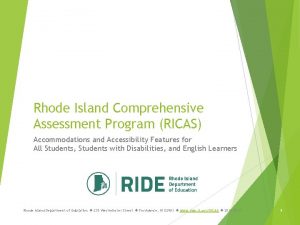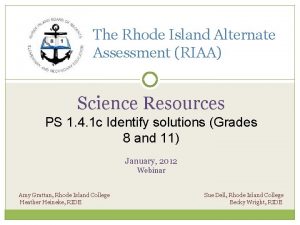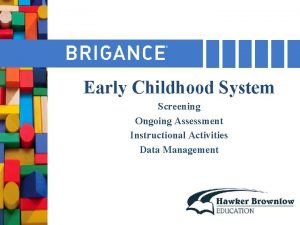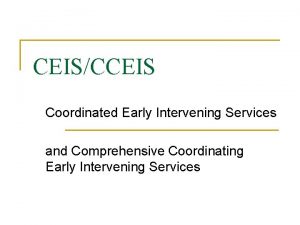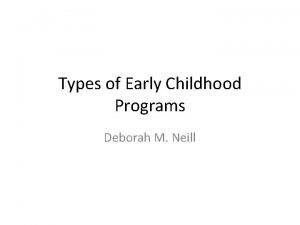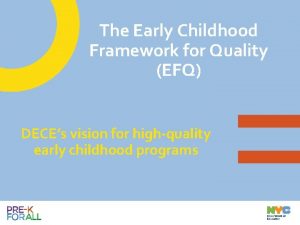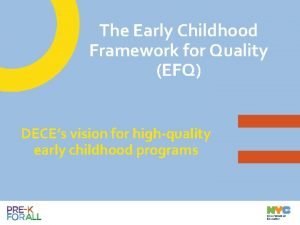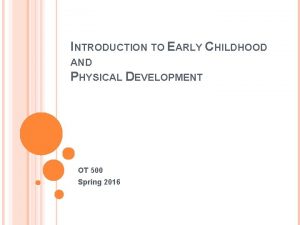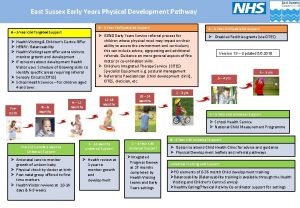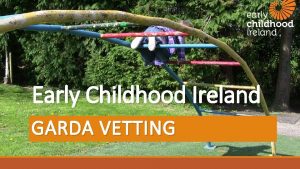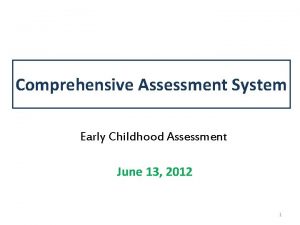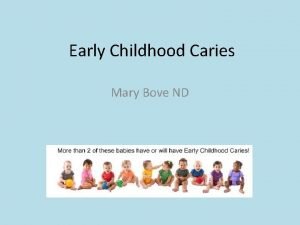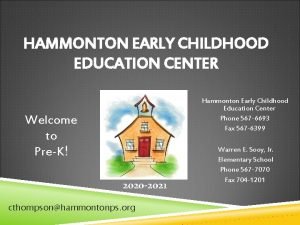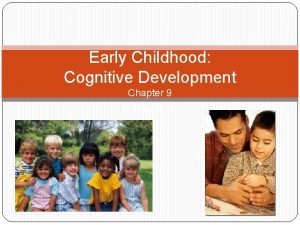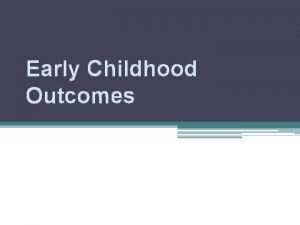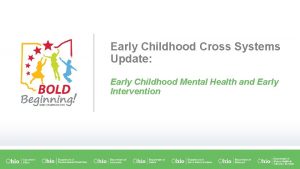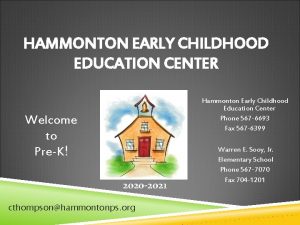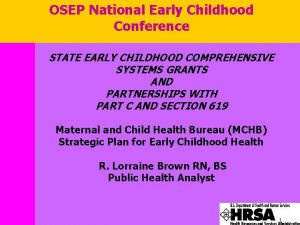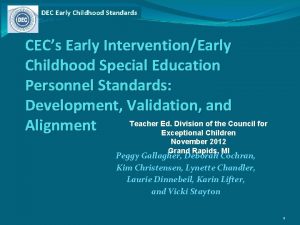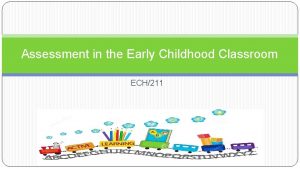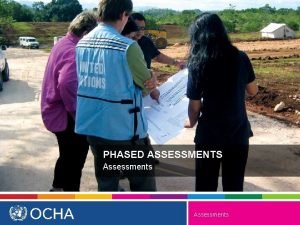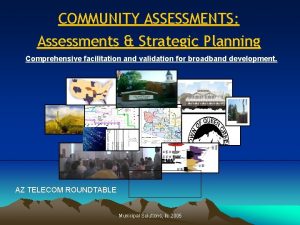Comprehensive Assessment in Early Childhood How Assessments Can



![More specifically…. • • • Improve transition [to kindergarten] Inform instruction in the classroom More specifically…. • • • Improve transition [to kindergarten] Inform instruction in the classroom](https://slidetodoc.com/presentation_image_h2/400849b4ccd1892f736d1947972f1010/image-4.jpg)
















- Slides: 20

Comprehensive Assessment in Early Childhood: How Assessments Can Shape Policy and Improve Practice Kathy Hebbeler SRI International Presented at State Kindergarten Entry Assessment (KEA) Conference San Antonio, Texas February, 2012

Purpose of the assessment is a critical driver of many other decisions Early Childhood Outcomes Center 2

Why build a statewide measurement system for young children? • Accountability • Program Improvement Early Childhood Outcomes Center 3
![More specifically Improve transition to kindergarten Inform instruction in the classroom More specifically…. • • • Improve transition [to kindergarten] Inform instruction in the classroom](https://slidetodoc.com/presentation_image_h2/400849b4ccd1892f736d1947972f1010/image-4.jpg)
More specifically…. • • • Improve transition [to kindergarten] Inform instruction in the classroom Inform parents of the child’s status Screen for delays or disabilities Determine the status of the population– social benchmarking Early Childhood Outcomes Center 4

And even more purposes… • Make planning decisions at the building, district, or state level • Examine the effectiveness of the program – Growth over one year* – Performance years later (longitudinal) *Need more than an entry assessment Early Childhood Outcomes Center 5

Decisions that follow from purposes • Who is assessed? • Who administers the assessment? • How often to assess? – [For KEA: Entry only or Entry plus? ] • What kind of assessment? • Who sees the results? • Who will (or is expected to) to act on the results? Early Childhood Outcomes Center 6

Results Matter Colorado and Nebraska Early Childhood Outcomes Center 7

http: //www. cde. state. co. us/resultsmatter/rm_system. htm Early Childhood Outcomes Center 8

System Features • Observation-based assessment completed by teachers – Significant investment in professional development • Assessment administered several times a year to all children in participating programs • Data entered online • Different levels of reports for different audiences (child, classroom, building, district, state) • Plans to link data to K-12 Early Childhood Outcomes Center 9

Program Improvement Purposes Inform instruction Early Childhood Outcomes Center – Data on all children • No sampling – Multiple time points (Fall, Winter, Spring) – Child and classroom level reports 10

What was learned… • Ongoing stakeholder involvement has been critical for buy-in – Initial decision-making and ongoing feedback • Teachers have embraced the observationbased assessments – Created an assessment culture – Results filled an information void • Up to 3 years for teacher to get proficient Early Childhood Outcomes Center 11

Program Improvement Purposes Improve transition Early Childhood Outcomes Center • Receiving teacher has access to previous year’s assessments 12

Program Improvement Purposes Make planning decisions at the building, district or state level Early Childhood Outcomes Center • Online system generates reports at the building, district, or state level • Administrators at these levels have access to the data 13

Program Improvement Purposes Determine program effectiveness Early Childhood Outcomes Center • Multiple points of data to examine growth over the program • System will link preschool assessment data for program attendees to K-12 data 14

Accountability Purposes • Generate state level analyses for federal reporting (only for children in EI or ECSE) • Produce information for the state’s annual report Early Childhood Outcomes Center • State has access to the data • State can analyze the data and produce many different kinds of analyses 15

Early Childhood Outcomes Center 16

Early Childhood Outcomes Center 17

Quality Indicators Components Elements Purpose Data Collection and Transmission Analysis Reporting Using Data Evaluation Cross-System Coordination Early Childhood Outcomes Center 1. State has articulated purpose(s) of COMS. 2. Data collection procedures are carried out efficiently and effectively. 3. Providers, supervisors, and others involved in data collection have the required knowledge, skills, and commitment. 4. State's method for entering, transmitting, and storing data is effective and efficient. Analysis State identifies accountability and program improvement questions related to child outcomes. Local programs identify accountability and program improvement questions related to child outcomes. Data Collection and Transmission 5. 6. 7. State agency analyzes data in a timely manner. 8. Local programs analyze data in a timely manner. 9. State agency ensures completeness and accuracy of data. Reporting 10. State agency interprets, reports, and communicates information related to child outcomes. 11. Local programs interpret, report, and communicate information related to child outcomes. Using Data 12. State agency makes regular use of information on child outcomes to improve programs. 13. Local programs makes regular use of information on child outcomes to improve programs. Evaluation 14. State evaluates its COMS regularly. Cross-system Coordination a. b. c. d. e. f. g. h. State has… State agency. . Representative. . State agency… State …… State provides… State has. . 15. Part C and 619 coordinate child outcomes measurement. 16. Child outcomes measurement is integrated across early childhood (EC) programs statewide. 17. Child outcomes measurement is aligned with state’s early learning guidelines/standards. 18. State has a longitudinal data system to link child outcomes data from EC program participation to K– 12 data. www. the-eco-center. org 18

Conclusions • Articulate the purpose(s) • Design the assessment system to align with the purpose(s) • Invest in building capacity – To collect data – To interpret and act on the data Early Childhood Outcomes Center 19

Additional Resource Kindergarten Assessment Process Planning Report (2008) http: //policyweb. sri. com/cehs/publications/WA_DEL_KRA_Process. Planning. pdf Report on a process to help Washington State plan for their KEA. Early Childhood Outcomes Center 20
 Infancy early childhood middle childhood adolescence
Infancy early childhood middle childhood adolescence Ricas english language arts
Ricas english language arts Rhode island comprehensive assessments system
Rhode island comprehensive assessments system Brigance readiness activities
Brigance readiness activities Early cpr and early defibrillation can: *
Early cpr and early defibrillation can: * Comprehensive coordinated early intervening services
Comprehensive coordinated early intervening services Three types of early childhood programs
Three types of early childhood programs Types of early childhood programs chapter 2
Types of early childhood programs chapter 2 Efq
Efq Efq
Efq Ecetp.pdp.albany.edu.elearning
Ecetp.pdp.albany.edu.elearning Green eggs early childhood centre
Green eggs early childhood centre Nsw department of education
Nsw department of education Leonardo da vinci's childhood
Leonardo da vinci's childhood Fine motor skills development in early childhood
Fine motor skills development in early childhood Trends in early childhood education
Trends in early childhood education Physical development in early childhood
Physical development in early childhood Ecrq author guidelines
Ecrq author guidelines Early childhood ireland garda vetting
Early childhood ireland garda vetting Psychosocial development in early childhood
Psychosocial development in early childhood Chapter 7 early childhood ages 3 through 5 answer key
Chapter 7 early childhood ages 3 through 5 answer key

